March 18 – Arethusa
"Arethusa, the dragon’s mouth orchid, defines March 18."
Arethusa symbolizes elegance and mystery. You have a captivating personality and an aura of sophistication. Like this orchid, you are rare and cherished by those who know you.
Arethusa: An Orchid of Nymphs and Bogs
My name is Ferb Vu, and I’ve always been drawn to the delicate beauty of Orchidaceae family. There’s something about their intricate forms and vibrant colors that speaks to a hidden world of wonder. Among my favorites is the genus Arethusa, a group of orchids named after a nymph from Greek mythology. These orchids, often found in the hushed stillness of bogs and swamps, possess a unique charm that captures the imagination.
The Legend of Arethusa
The story of Arethusa, as told by Ovid in his Metamorphoses, is a tale of pursuit and transformation. Alpheus, a river god, became enamored with the beautiful nymph Arethusa. Fleeing his unwanted advances, Arethusa prayed to the goddess Artemis for protection. Artemis, in answer to her plea, transformed Arethusa into a freshwater spring. Even in this new form, Alpheus continued his pursuit, mingling his river waters with the spring.
This myth, with its themes of transformation and the intertwining of water and earth, seems a fitting parallel to the Arethusa orchids, which thrive in the liminal spaces between water and land. Just as the nymph Arethusa found sanctuary in the cool depths of a spring, so too do these orchids find refuge in the secluded environments of bogs and swamps.
A Singular Beauty: Arethusa bulbosa
The genus Arethusa is currently considered monotypic, meaning it contains only one recognized species: Arethusa bulbosa. This lovely orchid, commonly known as the dragon’s mouth orchid, is a testament to the beauty that can be found in unexpected places.
Imagine yourself traversing a boardwalk through a tranquil bog. Suddenly, amidst the sphagnum moss and pitcher plants, a splash of vibrant pink catches your eye. A single, exquisite flower rises from the boggy ground, its delicate petals forming a shape reminiscent of a dragon’s gaping maw. This is Arethusa bulbosa, a beacon of color in the muted palette of the wetland.
The flower of Arethusa bulbosa is a masterpiece of natural design. Its labellum, or lip, is adorned with a fringe of white and yellow crests, adding a touch of elegance to its already striking appearance. The flower’s fragrance, though subtle, adds another layer to its allure, attracting pollinators to its hidden depths.
A Resilient Spirit
Despite its delicate appearance, Arethusa bulbosa is a surprisingly resilient plant. It has adapted to thrive in the harsh conditions of bogs, where acidic water and nutrient-poor soil would challenge most other plants. Its bulbous root system allows it to store energy and water, enabling it to survive periods of drought or flooding.
However, this resilience doesn’t make Arethusa bulbosa immune to threats. Habitat loss due to development and drainage poses a significant risk to its survival. Additionally, over-collection by orchid enthusiasts can further endanger its populations. It’s crucial that we appreciate this orchid’s beauty responsibly, ensuring its continued existence for generations to come.
Conservation and the Future
The conservation of Arethusa bulbosa and its fragile wetland habitat is of paramount importance. Efforts to protect and restore bogs and swamps are essential to ensure the survival of this unique orchid. Additionally, raising awareness about the importance of responsible orchid collecting and the threats facing Arethusa bulbosa can help safeguard its future.
As someone who admires the beauty of orchids, I feel a responsibility to advocate for their protection. Arethusa bulbosa, with its mythological namesake and its captivating presence in the bog, serves as a reminder of the delicate balance of nature and the need for our stewardship. By understanding and appreciating this remarkable orchid, we can contribute to its continued existence in the wild.
If i die, water my plants!



